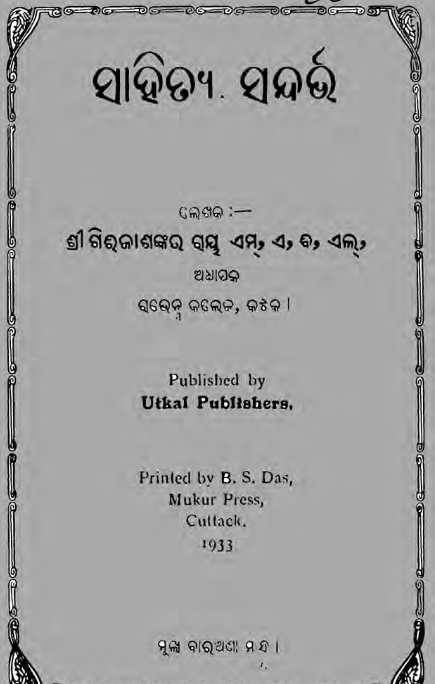Sahitya Sandarbha, published in 1933 by the esteemed Odia writer and critic Girija Shankara Ray, is a cornerstone in the field of Odia literary criticism. This work not only reflects the evolution of Odia literature but also encapsulates Ray’s profound insights into the intricacies of essays and the essence of literary art. Through Sahitya Sandarbha, Ray presents a compelling discourse on the significance of essays as a literary form, making it an invaluable resource for both scholars and lovers of literature.
At the heart of Sahitya Sandarbha lies Ray’s exploration of the essay as a flexible and impactful medium of expression. He examines the essay’s ability to convey personal thoughts, cultural reflections, and social critiques, positioning it as a bridge between the writer and the reader. Ray emphasizes that essays serve as a mirror to society, revealing the ethos, ideologies, and nuances of the times. He adeptly discusses various dimensions of essay writing, including its structure, style, and thematic variations, showcasing how these elements contribute to the overall impact of the text.
One of the salient features of Ray’s analysis is his focus on the stylistic diversity within Odia essays. He commendably spotlights the use of idiomatic expressions and regional aesthetics that resonate with Odia culture. By doing so, Ray encourages aspiring writers to embrace their linguistic heritage while crafting essays, thus fostering a deeper identity in the Odia literary landscape. This advocacy for cultural authenticity not only enriches the essays but also fortifies the reader’s connection to their roots.
Furthermore, Sahitya Sandarbha delves into the historical evolution of essay writing in the Odia context. Ray provides an insightful critique of notable Odia essayists, highlighting their contributions and the various trends that have shaped contemporary writing. This historical perspective not only contextualizes the present literary scenario but also situates Odia literature within a broader national and global framework. Ray’s ability to weave historical narratives with literary analysis enhances the depth of his critique, providing readers with a thorough understanding of the genre’s evolution.
Another significant aspect of Ray’s work is his understanding of the essay as a platform for intellectual discourse. He asserts that essays foster critical thinking and promote dialogue on pressing social issues. By advocating for essays that engage with contemporary challenges—be it political, social, or economic—Ray broadens the scope of the genre, urging writers to utilize their craft as a means of reflection and advocacy for change. This perspective resonates deeply in today’s literary discussions, where writers increasingly use their platforms to address societal issues.
In conclusion, Sahitya Sandarbha by Girija Shankara Ray stands as a monumental work in Odia literary criticism. It provides a comprehensive analysis of the essay as a distinct literary form while offering invaluable insights into the Odia literary tradition. Through his nuanced exploration of themes, styles, and historical contexts, Ray not only enhances the appreciation of essays but also encourages new generations of writers to engage with their cultural heritage and societal realities. This seminal work continues to inspire and inform, cementing Ray’s legacy as a pivotal figure in Odia literature. For anyone interested in the nuances of literary criticism or the dynamics of Odia writing, Sahitya Sandarbha is an essential read that promises both enlightenment and reflection.
Books Info
| Books name | Sahitya Sandarbha / ସାହିତ୍ୟ ସନ୍ଦର୍ଭ |
| Author | Girija Shankara Ray |
| No Of pages | 142 |
| Publisher | Utkal Publishers |
| Publication | 1933 |
| Printed At | Mukur Press |
| Distributor | NA |

